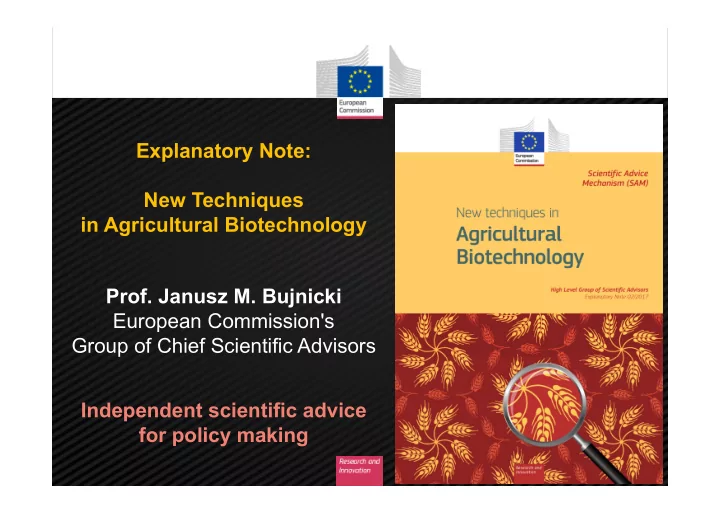

Explanatory Note: New Techniques in Agricultural Biotechnology Prof. Janusz M. Bujnicki European Commission's Group of Chief Scientific Advisors Independent scientific advice for policy making
Background: • Since the beginning of agriculture around 10,000 years ago humans endeavoured to improve their crops and animals. • We have selected plants, animals and microorganisms that give a greater yield, are more palatable, easier to process, etc. • Features of plants, animals and microorganisms that make them useful for agriculture are a result of an organism's genetic makeup, which in turn is the product of natural, spontaneous mutations.
Background • As technology has developed, the ways in which new varieties can be generated faster have become more sophisticated. • At first, chemical or physical agents (such as x-rays) were used to make random changes to plant seeds (induced mutagenesis); this procedure still requires selection of organisms with desirable traits. • More targeted changes became possible during the 1980s, involving the insertion of genetic material into organisms, some of which may be from other species (genetic modification, GM).
Background: • Recently, a variety of new breeding techniques (NBT) have been developed for agricultural biotechnology. • Some of them do lead to the inclusion of genetic material from other species or to changes of genetic sequences, while others don’t. • When changes to genetic sequences are made with a NBT, they are typically made in a more precise manner than those made with established techniques of GM.
Gene editing and CRISPR/Cas: Natural bacterial immunity system , which ”cleaves” DNA at programmed sequences Figure adapted from Annu. Rev. Biochem. 2016.85: 227-264. Downloaded from www.annualreviews.org
Gene editing and CRISPR/Cas: Can be used in various organisms for: - precise random mutagenesis - precise template-guided mutagenesis - precise removal or insertion of DNA/genes Figure adapted from Annu. Rev. Biochem. 2016.85: 227-264. Downloaded from www.annualreviews.org
CRISPR/Cas beyond gene editing Figure adapted from Annu. Rev. Biochem. 2016.85: 227-264. Downloaded from www.annualreviews.org
Frequently asked questions: • How do the NBTs (and their products) compare to - each other? - the GM techniques? - classical (natural?) techniques (e.g. in terms of precision, cost, speed, safety) • What is natural (observed in the nature) and what is not? • Can organisms obtained with different techniques - be detected? - be distinguished from each other?
We are all mutants! • All living organisms are subject to genetic alterations occurring spontaneously and due to environmental stressors. • These changes are the basis for evolution by natural selection. • All breeding techniques (CBT, ETGM and NBT) make use of genetic diversity and change in order to allow the selection of desirable traits.
Techniques and their products • Generally speaking: - organisms produced using CBT will not contain genetic material from organisms of other species, - those produced using ETGM usually will, - and those produced using NBT may or may not. • The end products of NBT do not necessarily contain genetic material from other organisms. Such material may be present in intermediate stages. • Some NBTs make no changes to genetic sequences at all.
Detection and attribution of changes • NBT of genome editing can produce precise alterations of genetic sequences (local mutagenesis) that can be undistinguishable from changes occurring naturally. • Without prior knowledge, changes are difficult to detect and the attribution of changes to a particular technique is generally impossible.
Unintended effects: • Classical techniques often produces many unintended effects • Unintended effects are not necessarily visible or harmful, either to the organism in question, or to those who eat it • Generally, genome editing techniques are more precise and result in fewer unintended effects than do CBT and ETGM • It is not possible to define the safety of a technique solely based on its precision and/or the likelihood that it will produce unintended effects
Safety: • Assessments of the safety (environmental, health, etc.) of the organisms produced by the new techniques can only be made on a case-by-case basis taking into account, amongst others: - the specific mutation, - unintended effects, - the species into which the mutation is introduced, - the environment in which the end product is used, - the agricultural practice applied, - and its planned use and exposure.
Recommend
More recommend